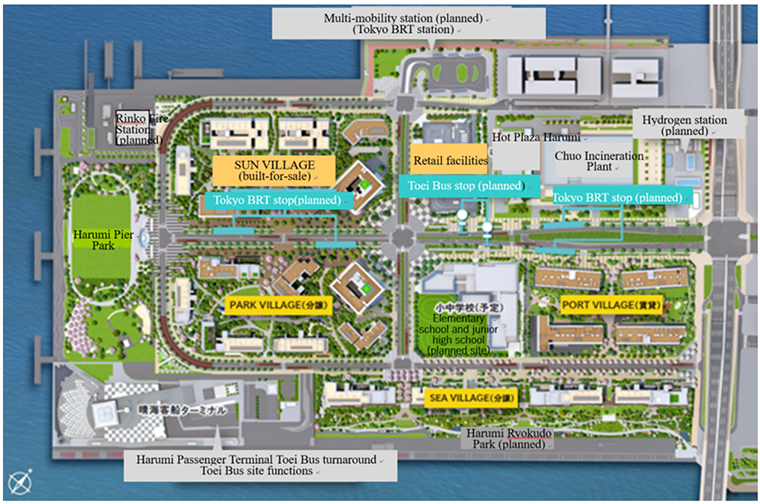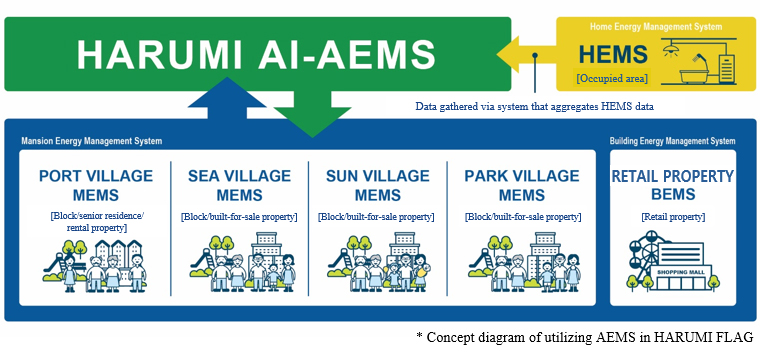Using state-of-the-art AEMS*1 and hydrogen energy to power a smart city
AI-AEMS to be installed in HARUMI FLAG
- Effective energy use made possible
with AI-based electricity demand forecasting -
October 10, 2019
Mitsui Fudosan Residential Co., Ltd., MITSUBISHI ESTATE RESIDENCE CO., LTD.,
Nomura Real Estate Development Co., Ltd., Sumitomo Realty & Development Co., Ltd.,
SUMITOMO CORPORATION, Tokyu Land Corporation, Tokyo Tatemono Co., Ltd.,
NTT Urban Development Corporation, NIPPON STEEL KOWA REAL ESTATE CO., LTD.,
DAIWA HOUSE INDUSTRY CO., LTD., Mitsui Fudosan Co., Ltd.,
Hitachi, Ltd.
Tokyo, Japan, October 10, 2019 - Mitsui Fudosan Residential Co., Ltd., a leading housing company headquartered in Tokyo, announced today that the 11 designated construction companies* of HARUMI FLAG and Hitachi, Ltd. (hereinafter, “Hitachi”) will deploy HARUMI AI-AEMS, an AEMS with an AI-based electricity demand forecasting feature, at HARUMI FLAG, the largest mixed-use development project in Tokyo.
The AI will provide accurate electricity demand forecasting made possible with the data modeling technology of Lumada* , an IoT platform developed and advanced by Hitachi in many business sectors, and deep learning technology. The energy operation, management, and control system will be based on the integrated energy and facility management service EMilia* .
HARUMI AI-AEMS will provide centralized management of a vast volume of energy information in each block of HARUMI FLAG to ensure efficient energy operation with an area network that connects the whole town.
The AI-based electricity demand forecasting system analyzes energy-related information (such as power usage and weather information) that it has gathered to enable more precise demand forecasts. As a result, AI-AEMS can formulate efficient hydrogen consumption and peak demand reduction plans (e.g., by operational control of facilities) for efficient energy use. The AI learning feature can also improve the accuracy of forecasts through repetitive learning.
Effective energy use with AI-AEMS reduces environmental impact and offers benefits for management costs including utility bills.
HARUMI FLAG is a large-scale urban development. It has 23 residential buildings with 5,632 units and retail property, and is expected to have substantial energy demand. Although it is mainly a residential development, AEMS is being used because of HARUMI FLAG’s complex energy management requirements due to the use of multiple infrastructures and alternative energy such as hydrogen and solar power. Being a large-scale project whose buildings were developed concurrently made it possible to adopt HARUMI AI-AEMS, which we hope will help HARUMI FLAG smart city serve as a flagship of future urban planning.
- 1: AEMS: Area Energy Management System
- 2: A designated construction company is a company participating in the program that allows private companies to construct buildings in urban redevelopment projects on behalf of the executor (Tokyo Metropolitan Government).
- 3: Lumada is the collective name for solutions, services, and technologies that harness Hitachi’s latest digital technologies whose goal is to create value from customer data and accelerate digital innovation. For details, please refer to Hitachi’s website (http://www.hitachi.co.jp/products/it/lumada)
- 4: For details on EMilia, please refer to Hitachi’s website
(http://www.hitachi.co.jp/products/infrastructure/product_site/emilia/index.html)
EMilia is a registered trademark of Hitachi, Ltd. in Japan.
■Features of AEMS at HARUMI FLAG
Enables energy management of the whole town
The HARUMI FLAG AEMS works with all energy management systems in the area, namely MEMS (Mansion Energy Management System; block based), HEMS (Home Energy Management System; residential unit based), and BEMS (Building Energy Management System; retail unit based) for integrated data management. This provides access to detailed energy data (previously available only by block) for the whole town. Data integration not only visualizes the results of initiatives implemented by the town but also enables analysis of usage trends per block. Energy consumption and forecast data gathered and computed by AEMS can be disclosed to residents via the town portal or by digital signage to raise awareness of the importance of reducing environmental impact.
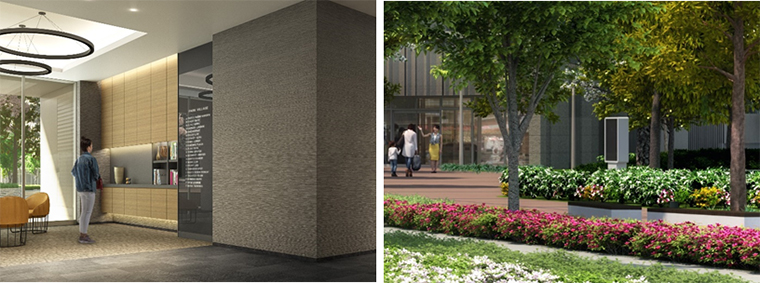
Touch panel and digital signage that displays real- time information such as the town’s overall energy consumption (image)
■Features of HARUMI AI-AEMS
1. Projected electricity demand
The system learns the causal relationship between weather information, information on local events, and past electricity consumption and trends to forecast electricity demand. The AI is self-learning, excluding weakly correlated data in making forecasts and growing as it builds up operational performance data, and improves the accuracy of its forecasts as the town develops.
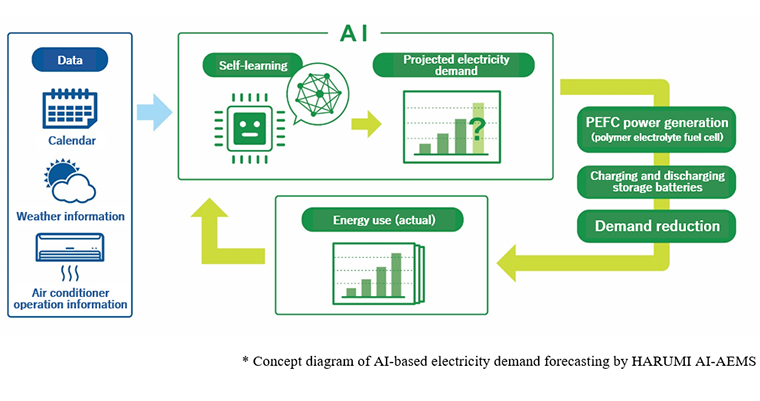
2. Formulating an efficient energy consumption plan that includes use of hydrogen power
HARUMI FLAG will be the first case in Japan to receive hydrogen via a pipeline from a hydrogen station maintained nearby that serves as major infrastructure. Power will be supplied using an on-site polymer electrolyte fuel cell (PEFC). HARUMI AI-AEMS will forecast the electricity consumption trends of each block, and formulate and operate annual hydrogen usage plans. HARUMI FLAG has multiple energy infrastructures, including hydrogen, solar power, and storage batteries. Its goal is to become a town that manages diverse energy sources efficiently.
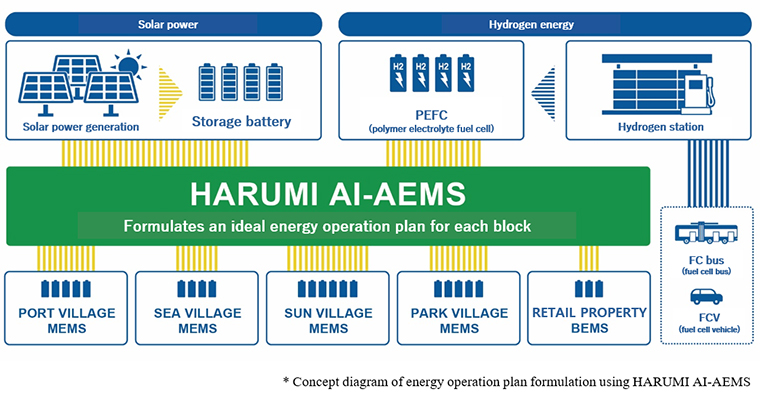
3. Formulating energy usage plan with the goal of reducing peak demand
The system determines peak periods for energy usage for each block based on electricity demand forecasts and formulates charge/discharge plans for storage batteries connected to solar panels and operation plans for the polymer electrolyte fuel cells (PEFC). Communal facilities such as lighting and air conditioning systems are automatically controlled and operated based on the operation plan. The system prevents peak power demand from happening in the first place by forecasting peak demand and performing efficient energy management.
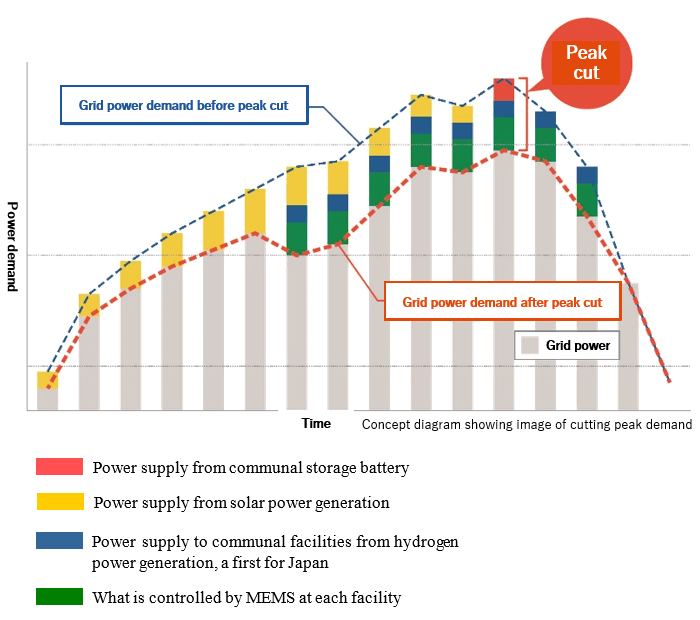
4. Securing power supply in a disaster
Lifelines are protected at HARUMI FLAG in emergencies by having storage batteries, emergency generators and PEFCs supply power to specified communal facilities. Energy management by AEMS operates with precautions in place such as ensuring that some electric power is stored in storage batteries. It also analyzes electricity usage trends based on operation performance data during disasters so that it can forecast the length of time that it can continue to supply power to support operations during and after a disaster.
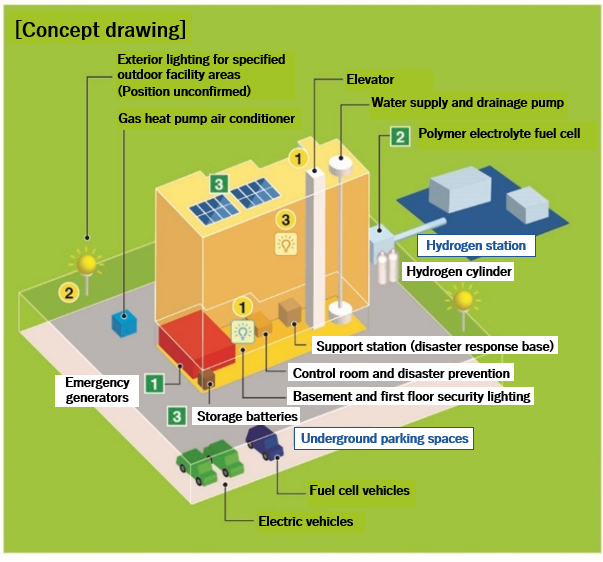
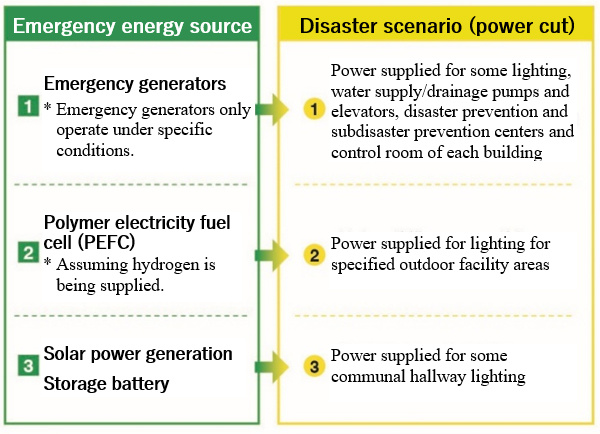
■Hitachi’s AEMS initiatives
Hitachi provides EMilia, an integrated energy and facility management service for integrated management of energy data and facilities of multiple locations (offices, factories, stores, areas, etc.) to save energy, improve business efficiency, and ensure business continuity planning (BCP). As an AEMS, EMilia has been adopted by Kashiwa-no-ha Smart City in Kashiwa, Chiba Prefecture, which is developed and operated by Mitsui Fudosan. Hitachi will help to raise the social and environmental value of HARUMI FLAG through the provision of a safe and comfortable space for residents and users by harnessing its experience and know-how as well as the latest digital technologies such as AI, developing and deploying AEMS, and utilizing highly efficient energy such as hydrogen.
■HARUMI FLAG Overall Development Overview
| Total development area | 1,441,355 ft2 (133,906.26m2) |
|---|---|
| Total planned units | 5,632 residential upertynits (4,145 units in built-for-sale districts, 1,487 units in rental housing districts (including senior housing and shared housing); also, stores, nursing homes, daycare center (block numbers TBD), and retail pro |
■Development Overview of Each HARUMI FLAG District
| PORT VILLAGE | SEA VILLAGE | SUN VILLAGE | PARK VILLAGE | Retail property | |
|---|---|---|---|---|---|
| Main Uses | Rental housings (including senior housings and share houses), nursing homes, and daycare facilities | Residential housings | Residential housings, retail stores | Residential housings, retail stores | Residential housings, retail stores Retail property |
| Location | 501, Harumi 5-chome, Chuo-ku, Tokyo | 502, Harumi 5-chome, Chuo-ku, Tokyo | 503, Harumi 5-chome, Chuo-ku, Tokyo | 504, Harumi 5-chome, Chuo-ku, Tokyo | 505, Harumi 5-chome, Chuo-ku, Tokyo |
| Site area | 283,092 ft2 (26,300.14m2) | 254,386 ft2 (23,633.20 m2) |
403,014 ft2 (37,441.27 m2) |
378,629 ft2 (35,175.79 m2) |
122,233 ft2 (11,355.86 m2) |
| Number of buildings | 4 | 5 | 7 | 7 | 1 |
| Number of residential units | 1,487 | 686 | 1,822 | 1,637 | - |
| Floor(s) | 15-17 floors above ground, 1 floor below ground (block-type building) | 14-18 floors above ground, 1 floor below ground (block-type building) | 14-18 floors above ground, 1 floor below ground (block-type building) 50 floors above ground, 1 floor below ground (tower) |
14-18 floors above ground, 1 floor below ground (block-type building) 50 floors above ground, 1 floor below ground (tower) |
3 floors above ground, 1 floor below ground |
| Parking spaces | 312 | 313 | 831 | 758 | 104 |
■Site Layout
